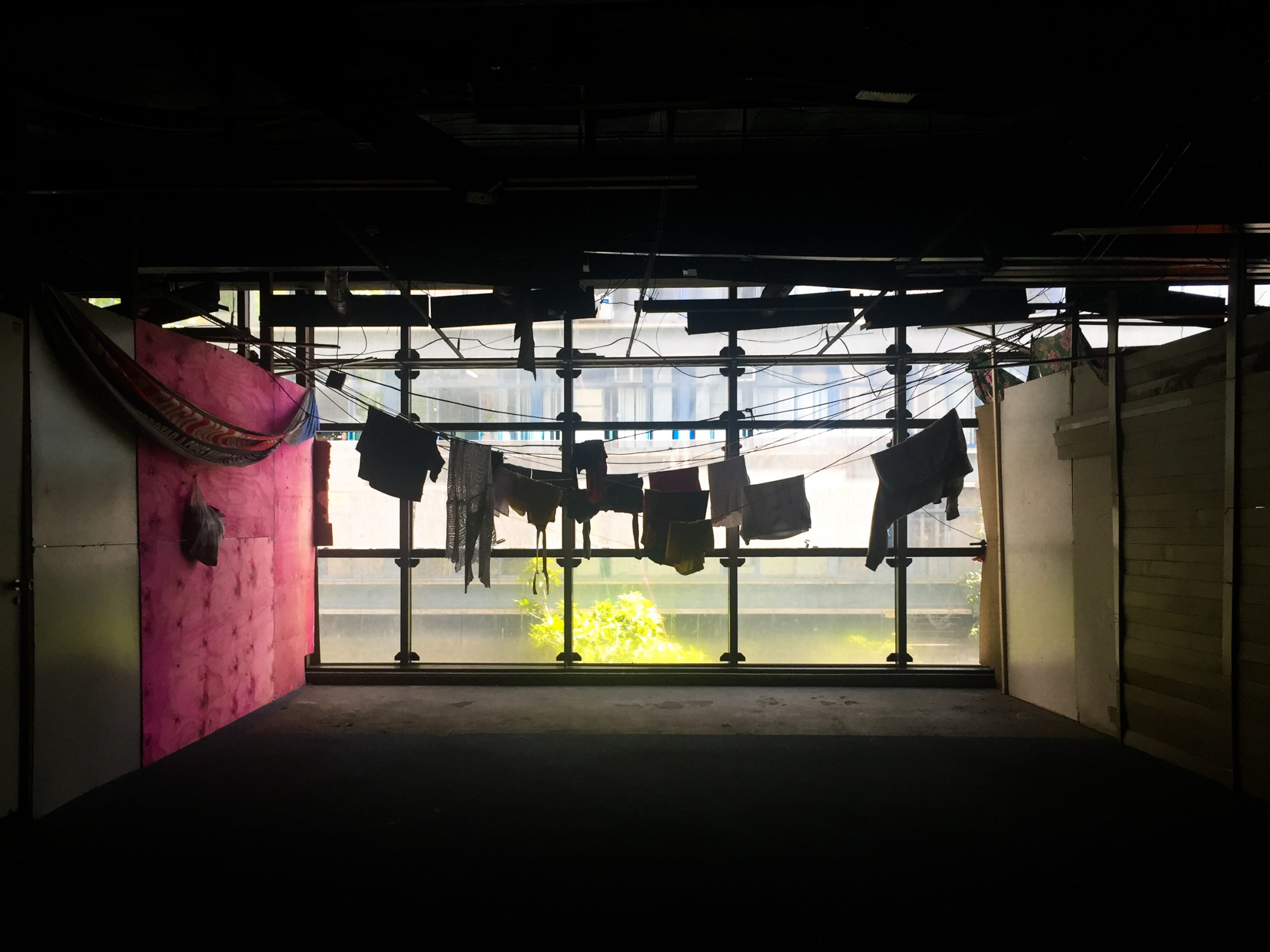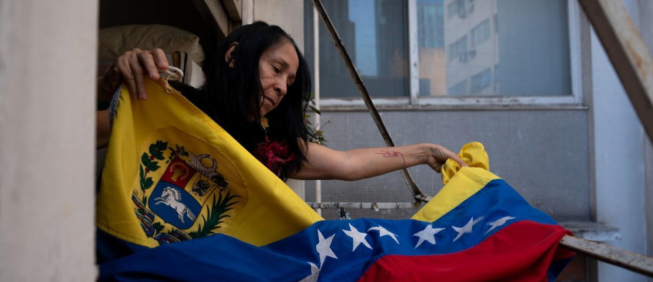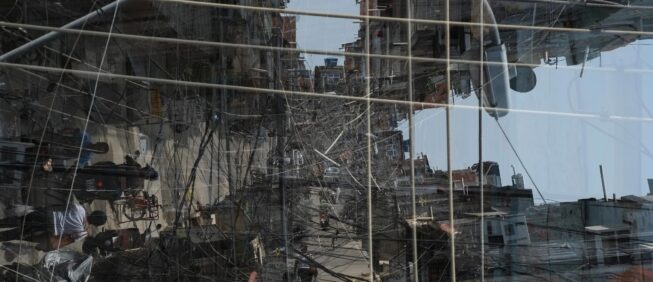Housework without houses: women in nonconventional housing
Institutional logic versus the unexpected positives of "atypical" living situations
Luna Lyra
Silke Kapp
Grupo MOM
| Brazil |
19 de July de 2019
A question and a way forward
How do women deal with the work of reproduction in temporary, interim, and unstable living situations? This was the question collectively defined by the authors of this text, within a study that seeks to broaden knowledge on the socio-spatial struggles in a feminist perspective and, at the same time, to critically rethink some of the research practices in architecture, urbanism, and planning. Despite advances made over the last several decades, these areas are still founded in paradigms of misogynist, racist, elitist frameworks in which the problems of women are secondary or invisible, resulting in public policies that privilege the provision of “infrastructural and institutional elements… in detriment to urban infrastructure aimed at social reproduction” (Costa and Magalhaes, 2011, p. 11). The tacit assumption persists, ingrained in the history of capitalist societies (cf. Federici, 2017), that women will find a way to maintain a functioning domestic life, whatever the circumstances. If the necessary outcome of this is “shadow work” (illich, 1981), off the radar of the fields of power, what is to be said of the domesticity without domus?
We seek to deepen the comprehension of implications in this scenario for women, exploring the interview as a method for data collection. Interviews allow for deciphering, through a “two-channel listening” (Anderson and Jack, 1991), the subjective experiences and collecting experiences that, in the women’s own words, tend to appear only on the sidelines of and subordinated to dominant discourse. We hoped to reach aspects that the usual data collection methods in diagnostics and urban planning (direct observation, questionnaires, statistics, etc) neglect or ignore, and that do not reveal themselves in shallow interview proceedings—that is, emulations of consolidated formats without critical reflection on objectives, possibilities, and limitations. The study was thus structured in four phases: the definition of the aforementioned research question; the development of interview proceedings that would allow for the collection or construction of data relevant to said question; the realization and transcription of interviews; and the analysis and discussion of data.
Interviews were conducted, as a rule, by a pair of female researchers in the form of a guided interview (not semi-structured; cf. McIntosh and Morse, 2015), exploring a range of topics based on contexts and the women’s speech. We gave emphasis to the narrative character (cf. Schutze 1983, Elliot 2005), not only because the telling of stories favor the desired two-channel listening, with expressions that would rarely appear in direct questions and answers, but also because stories always take place in a space (physical or social) and naturally mention perceptions and representations related to that space. Furthermore, we sought to maintain a single focus: the implications of the specific circumstance in a determined moment or period (and not the entire life story of each woman interviewed). For the selection of the interviewees, we appealed to previous contacts in provisional situations, such as forced eviction. This included urban occupations in buildings in the city center or in peripheral areas, shelters for women in situations of domestic violence, non-consolidated favelas, social housing, migrations in search of work, and women under medical supervision. One central requirement was that the interviewed women were living or had lived through an experience of housing instability with dependents, that is to say, children or others under their care.
Each interview was transcribed and then analysed by two different researchers. The sharing of perspectives that would emerge from these two analyses brought us to catalogue three recurring themes: what we would call spatial contrasts, maternal responsibilities, and relations to macrostructures. These certainly do not encapsulate all of the experiences narrated to us, but they do synthesize some of the most relevant aspects. From these, we analysed each interview one more time, seeking to construct hypotheses that could serve the continuity of investigation. The material produced often surprised us, standing in contrast to expectations and presumptions until then not reflected upon. The following items present the three themes and a brief assessment, always keeping the central research question in mind: How do women with dependents in situations of provisional, temporary, or unstable housing deal with the structures and tasks of the work of reproduction? Suffice it to say that the question itself would come to seem limited by the end of this process. In a number of cases, the provisional situation represented, rather than a desperate race back to conventional tasks, a radical change in feminine submission in private, public, and collective spaces.
Spatial contrasts
Socio-spatial situations and relations are themes that “laypeople” do not usually analyse spontaneously, in that direct questions in this respect almost always result in poor responses, full of cliches and expected answers. For that reason, we attempted to understand configurations and appropriations of spaces through the way in which they appeared in the narratives of interviewed women in their everyday experience and their trajectory. In many cases, they were presented through contrasts, as much through urban spaces as through stable domestic spaces—passed or present, real or imagined—and the unstable spaces in interim setups. Sometimes the pole of instability corresponded to a negative representation and the pole of stability, the positive representation. There were also ambiguous representations and even opposite ones: that is, answers that emphatically dismantled the association of having one's own house with family and happiness, instead referring to the provisional situation as more open, free, and potent.
The trajectories narrated by T. and R. are similar, and fall into this last group. As victims of domestic violence, these women left typically housing situations of relatively high comfort and consumption, went from police stations to shelters, and stayed some months at a women’s support house until they arrived at an urban occupation in the center of the city. Both contrast conventional living, where they were abused and attacked, with occupation, which is more precarious, but represents for them a place of “security, support, strengthening” (R.) The old house “was a pretty little planned out home, but there was no peace” (T).
Arriving [at the occupation], I became empowered. And after that, I learned to live together with people in the collective, which was something I wasn’t used to, because we are, in our house, very individualist. I learned to share space, share food, share clothes even (R.)
R. observes that the experience changed racist, classist, and socio-spatial visions that she had held — “I judged the people in favelas [...] I learned in the occupation that this was pure prejudice.” Today, she questions the idea of the nuclear family and says that, when she concludes the division of property with her ex-husband, she intends to sell her house and donate the money to the occupation.
Yes, I changed a lot. Because we are free. I do what I want, when I want [...] That vision of the majority of people that stay trapped in a home and think that everything is nice and good, that’s not for me anymore [...] I don’t want to ever go back to my house. I intend to stay here. I don’t want to leave.
T., on the other hand, met a new partner and moved with her children to her new house, but the passage through collective housing strengthened her in the establishment of domestic relations that were much more equal than before.
D. was kicked out when, after the disasters of Mariana and Brumadinho, the mine company Vale decided to evacuate the region of the Vilarejo dos Macacos on account of the risk of another dam break. When the siren blared that morning, she and her husband left everything they had: personal possessions, furniture, a house, a yard, a garden, an orchard, as well as the restaurant that sustained them, the birthplace her godfather had built for them, and a network of neighbors, friends and services they trusted. Since then, they have been installed at an executive hotel in an upper-class neighborhood of Belo Horizonte with D’s mother, her baby, and two dogs. Before, D. would spend the day at her restaurant, “there on the edge of the street, watching the people go by [...] talking to people, working, attending to customers.” Now she says that she feels trapped and “really alone, as though I were in a separate bubble”; “we’ve got no income, we are just living off the hotel, eating and drinking here.” D. has tried to recreate what she calls “my mini-world, just like I had back there in Macacos.” She made friends with the hotel staff, she takes her baby to the square, and tries not to die of boredom. But she lost the ability to decide and act within her own space, which used to mean things like using her sowing station, which she constructed “with my own hands,” pulling cassava from her garden and inviting her friends to a cookout. Other symbolic appropriations, traces, and memories do not fit within the sterile space of the hotel or in her new urban context, where everything is predetermined. If D.’s situation seems, in principle, to confirm the positive value of stability (of her house) over the negative value of temporary housing (the hotel), it may also be interpreted in the opposite way: her old house was open to transformations (less stable in this sense), while the hotel is sealed and immune to the actions of its guests (more stable, therefore).
The story of Dona C., a woman of more than 80 that migrated from her rural area to Belo Horizonte in the 1960s, presents a significant contrast between what she thinks and feels and what the technicians from state bodies consider to be correct. Dona C. and her children lived in a number of different informal settlements, were removed by both floods and public works projects, until she managed to get a house in a village with a friend. But the situation was temporary, or at least it was in the point of view of urban politics; so much that Dona C. was obliged to leave her house for an apartment in a nearby area: “it has been thirteen years that I have lived here and I have never liked this apartment. There, I had my plants and here there is no way to have plants.” The type of living and the daily arrangements that were possible in village spaces are prohibited in the apartment “little buildings,” though they supposedly replace supposedly precarious living situations with other, so-called decent ones.
Beyond the housing types in themselves, contrasts in urban structure were mentioned in a more ambiguous manner than we had supposed. Interviewees that came from the periphery to the city center or vice-versa saw different advantages to one over the other. The city center eased access to work, school, and services at the same time that it restricted the relationship between domestic life and public space: “I am not a street vendor, I don’t want to live downtown. What I am going to do there? Be trapped at home with that noise of the bus in my head all day? No! [...] There are neighborhoods that you don’t even need to head downtown, because the neighborhood itself has everything, right?” (G.). Another interviewee (A.) resolved the issue by splitting her time between homes: during the week she stayed at a vertical occupation downtown, and on the ends of the weekends, at a horizontal occupation in the periphery.
P., a middle-class woman that, in a period of a few years, moved a number of times between a European capital and Belo Horizonte, spoke of the contrast between forms of living and organization in the routine of each respective context. This refers to, on one end, the urban infrastructure and its effect on social reproduction, which was much better in Europe. On the other end, P. allowed us a glimpse of the contrast between the area where she felt to be made inferior and discriminated against, and the one in which she felt a certain social privilege. In Europe, she was able to resolve her routine tasks near her home, by foot, or with public transportation, but she had to shoulder everything alone: “babysitters and maids don’t exist [...] you really have a lot of your time tied to the kids’ schedule.” In Belo Horizonte, her routine is less rigid, but depends at all times on the help of other women (including those that are made available by social inequality and that, here, are effectively made to feel inferior and discriminated against). Neither of the two situations seems ideal to her. She is considering staying in Brazil but moving to a smaller city.
Maternal responsibilities
In the nuclear family that historically made up the structuring cell of bourgeois society, each mother took on, almost always alone, the responsibility for her children’s upbringing and all of the energy and patience that this requires. Her possibilities from education, work, political engagement, and leisure are restricted in this process. “When you have children, you have to prioritize them. Either you think of yourself, or you think of your kids” (R.). In the temporary housing experiences of the women interviewed here, these routines of care, their logic, and their assumptions were altered—sometimes drastically and not always for the worse.
The individual responsibility of care is characteristic in P.’s narrative, who has made an effort to soften the effects of the housing transition on her daughters. In the moves between Europe and Brazil, she brought the children's belongings and left her own behind. “With moving so much, going from one side to the other, I ended up much less attached to my things. I don’t hang on to things anymore. Why would I?” She tries to replicate here the domestic space and urban routine that her daughters were used to, “to imitate a little the conditions” of living abroad.
Various interviewees took on situations of temporary housing with the sole objective of improving the lives of their children. Dona C., who migrated to Belo Horizonte in search of medical treatment for her daughter, is an extreme example in this sense. Of the 16 children she had, only four are alive today: “a number of them died back there, and since I have been here, four more have died.” At the same time that Dona C. says taking care of children is a nontransferable obligation for mothers. (“Thank God I never left any of my kids with someone else to take care of them”), she seems to not see maternity and its sufferings as obligatory: “Now [...] everyone has opened their eyes to this pill that lets you avoid having kids.” The fact is, for her, caring for her children was the only way to make things work.
I didn’t have a job and I wasn’t used to working, and I was really a small kid. From there, I started looking after other people’s kids, to earn some money. [...] My house was like this [makes a gesture to indicate her house was full of kids]. The money I earned from looking after the kids was enough for me to eat and to pay my social security. Now, I’m retired with that social security money that I paid (Dona C.)
G. went to an occupation because, after she gave up her job in order to care of a son with epilepsy, she was no longer able to pay her rent: “even if it were not for my son, I wouldn't have stayed back there.” Without an additional source of income, she ended up taking on the work of handling the occupation’s community daycare center. She thinks that “the majority of moms there [in the occupation] liked being away from their kids. They didn’t want to know what their kids were up to. In the beginning, I was the one bringing the kids to school.”
As indicated in this last quotation, not all mothers in atypical situations of housing and socio-spatial organization cling to the traditional feminine role. We have mentioned the cases of R. and T., which, in the occupation (not the same as G.), experienced a sharing of tasks and responsibilities that, beforehand, they wouldn’t even have been able to imagine. The mutual help allowed for activities that would have been impossible in a conventional situation, like studying and working with a certain scheduling flexibility.
There is no ‘I’ here, there is no neighbor, there is only us. So, it’s a great safety. I can go to work with no problem, I leave him [her three-year-old son] at school and they [she points to neighbors, men, who are washing clothes nearby] go pick him up for me. And here, he can go anywhere and he’s safe. Any family here, if they catch him going down the stairs, takes care of him. So, there is a specific person, but you don’t need to just have this one specific person, because wherever he goes, he is well taken care of [...] You find support to help you with your kids. (R.)
In this case, childcare stopped being seen as a maternal and individual task, and women opened more space for their personal and public lives, including public engagement. K. had lived in an occupation in the city center that was removed, and today she rents a place farther away from the city center. But the process of occupation, where she had taken on a leadership role, allowed her to discover a political vocation beyond the role of taking care of her kids. To the woman that managed the community daycare, K. said, “I take off my hat to her, because kids aren’t for me.” Today, she remains active in the movement for housing, and, to take on that work without having to bring her children, she made an arrangement with her neighbor. For A., another interviewee who is very engaged in the movement for housing, weekends in the periphery have turned into a rest period from motherly tasks. Without hesitation, she tells us that she goes to the occupation in the periphery while “they [her children] stay here [...] they don’t like it there [...] it would be a fight to get them to go.”
Relations with macrostructures
Macrostructures and institutions—such as Mayor’s Offices, public services, the police, the public ministry, mining company, churches, NGOs, and social movements—shape the lives of the women interviewed here in myriad ways. As was expected, all of them depend on the proximity of health services and schools, and orient their territorial decisions based on access to them (Dona C. went to live close to a large hospital when she came from the country in search of treatment for her daughter; G. rented a house in a neighborhood in which her kids could go to school on their own; P. entered her daughters in a school they could get to by foot, etc.) But macrostructures and institutions are also the causes of evictions and temporary housing situations, just as much as more or less effective support services in critical moments. It became evident in the narratives that such structures often are far from fulfilling what women consider to be their preeminent needs, at the same time that nebulous attributions and institutional hierarchies make things even more complicated. Many of the women interviewed here us the word eles (them, masculine) to refer to instances of power (public or not) that they don’t identify clearly but that affect them. Given the asymmetrical power balance, tactically weaving around daily problems seems, to them, preferable to confronting such instances.
The discrepancy between the institutional logic and the needs of women is drastic in the case of D. Perhaps the Vale company installed her family in a hotel room in the middle of Belo Horizonte with the conviction that, compared to her house in the vilarejo, this would be a favorable or even luxurious option. Actually, it was a total loss for her autonomy and identity. Everything came to depend upon the gifts of the company, which pays for her lodging, but does not compensate for the couple’s income (“if I want to go down to the corner store and buy a tampon, I can’t”) and doesn’t offer ways for the couple to establish themselves in another place. Absurdly, Vale is now urging them to return to their old house, since a technical diagnosis has determined that, if the dam were to break, the mud would ‘only’ surround the house, without covering it. Clearly, D. does not wish to run the risk, but nor is she able to imagine an effective strategy or alternative.
We still try to stay grateful, because we are alive, we are together, we have shelter, you see? [We] don’t know for how long, we don’t know if Vale will try to… There’s a huge fight going on with the Public Ministry. We have to constantly speak up because they’re trying to cut some benefit we have… ‘Benefit’ — and I don’t even know if that’s what it should be called, because we feel like such beggars here, you know? I’m not asking for anything beyond what I had at home. My life here is eating, having breakfast, lunch, and dinner at the hotel. I sleep, I bathe. That’s all I do. It’s like your life is on hold. You don’t know what to plan for. (D.)
Dona C.’s long history is full of this same kind of violence. She has gone through various episodes of removal and never had any way to protest. The two channels are clear in the way she speaks: one of conventional discourse and another of a subjective experience running counter to it. She complied with a removal justified by flood risk, just to return to a different house in the same village: “they wanted to get me out of there, and I didn’t want to leave, because I was finishing [construction on] the rooms [on the second floor].” She reports, with no sense of exaltation, that when the river rose and flooded her house she “took all the kids out in the rain and went to the plaza until the water went back down [...] It wouldn’t take long.” On the river channeling by the City Government:
They found a way with the river, and it dried up. Here, around where the tree in this yard is, there was a well. It was full of fish, it was a huge well. It dried up when they got the river in order. The water here dried up too, it was done, done. And all of this was removed. Back then, they removed houses. It was a big favela here. They took me out, they took everything out.
Expressions such as “found a way with” (dar um jeito) the river or “got the river in order” (arrumaram) echo the disastrous technical paradigm adopted in the majority of Brazilian cities in dealing with urban water (draining, channeling, flowing), at the same time that the memory of the “huge well” full of fish and phrases like “it was done, done,” and “they took me out, they took everything out,” spoken in a sorrowful tone, indicate the opposite.
Relations that are not explicitly violent, but are still dissonant between institutions and subjective experiences, appear in R.’s story. The women’s police station where she sought help in order to protect herself from her abusive husband offered her housing for her and her three children where she would be obliged to stay at home the whole time and give up both her job and the degree she was pursuing at the time.
While the aggressor should be put in jail, who ends up being jailed is the victim. [...] When you look for a place to protect yourself, you don’t think that you are going to stay there, trapped. You don’t want that kind of protection. You want protection, but a protection that gives you freedom of choice and freedom of movement. (R.)
Just as, paradoxically, the public institution created to support women in situations of violence didn’t offer choices or and way for her to continue her work or studies, R. ended up going to a house maintained by a women’s movement (and not by the state, that has threatened rather than maintained this house). There, she found the kind of protection she was looking for: a well-articulated structure of mutual help and encouragement that allowed her to pursue non-domestic activities and later placed her in contact with the occupation where R. currently lives.
However, occupations are also not exempt from hierarchies and power disputes. The social movements that organize them are seen as “the forces that are there to have their voice and impose their rules, because it’s necessary” (K.), creating a dependency of residents in relation to internal and external leaders. In the occupation that K. and G. participated in, there were also conflicts between the different movements involved: “each movement had their own way, they had their rules. [...] Things started to go overboard when these forces started to have different goals, or to be more than the other.” (K.). The “different goals” are in relation, for the most part, to negotiations with public organs, which go from palliative measures (such as rent support), promises, to more or less direct acts of aggression. Genuine negotiation requires relative power balance between all parts, which does not occur in these cases, save for in cases with massive public support. Both G. and K. report the brutality of the technicians at Cohab [the city housing organization] to speed up everyone’s exit when the occupation was removed from the building. They lost a lot of furniture because there wasn’t time to move all of the families with the single car they were able to make available.
Cohab said “No, you won’t be able to remain in the building. [...] You want a deal, right? Then, we’ll give you a month to leave. Once you leave, we’ll deposit the rent money. If you miss the deadline by one day, you’ll lose the deal and you’ll have to leave the building by force” (G.)
We had a negotiation going on. There was no need to do that [to threaten us], you know? In that way, as though we were being evicted… under pressure, in total chaos. It was really sad to see. For me, I saw the struggle stop right there. (K.)
Even so, K. says that her experience in the occupation made her think that she could, in fact, face institutionalized structures.
It [the occupation] gave me some knowledge about my rights, and about the rights of others. It made me see that we, when we united to fight for our rights, we can win. [...] I also took with me the need to get out in the streets and mobilize, to not just sit there on the couch (K.)
A brief assessment
Women’s struggles in and for the territory, whether pertinent to housing or other spaces, are part of themes that are broader and more complex than reflected in current urban policy. Measures such as preferential titling for women in housing programs may favor them, but they reinforce outdated convictions on the domestic unit and the respective role of the woman. The study elaborated above, with all of its limitations, offers a number of concrete paths in this area. First, our research indicates that single-family housing, isolated from public contacts and income sources, with few opportunities for exchange, moments of solidarity, or politicization, is far from being a universal desire among real women (different from the women abstractly imagined by planners and project designers). Atypical situations at times represent experiences of freedom, and empower the imagination for action.
Second, the data that we obtained indicate that the maternal ideal is ambiguous. Women feel responsible for their children, whose well-being is more important to them than the quality of the housing space. However, even so, children are not always and necessarily their absolute priority. Furthermore—and this is nothing new—the nuclear family, formed by a married couple and children, has ceased to be the predominant form of living. This demands deeper research into those forms of habitation seen as atypical, or even indecent. That is, there is a need to understand, promote, and experiment with alternatives such as collective housing, with varying levels of privacy, intergenerational presence, connections to varied income generation activities, and inserted in different ways into urban, rural, and rural-urban areas.
A third aspect taken from the interview analyses deserves additional mention: that of the institutional support offered to women in circumstances of instability. As things stand today, this support consists of insertion into a determined, rigid, structure that meets so-called basic needs, but restricts autonomy, and, consequently, the restructuring of one’s own life—whether this structure is a hotel, a typical apartment, or a shelter that prohibits mobility. R. condensed this issue well when she remarked “You want protection, but a protection that gives you freedom of choice.”
Finally, regarding our research question: on inquiring how women deal with the work of reproduction in situations of unstable housing, we were aware that the responsibility of women for this work is not a ‘natural’ fact, but a social construct. However, we operated from the assumption that it would be more difficult to deal with the (conventional) work of reproduction without (conventional) housing. We did not question the notion that the one-family housing unit favors the type of task and obligation fulfillment that our society, as it stands, attributes to women. This was shown to be false by the data we obtained in our interviews. As much as the women interviewed here may have glorified—for themselves and for others—the instability of these situations, it is undeniable that a number of these cases relieved the weight of work of reproduction rather than increasing it. It is worth asking to what extent the ideals of housing, objectively and subjectively determinant of so many spaces and desires, contradict themselves.
Acknowledgements
Our sincere thanks to the Coordination for the Improvement of Higher Education Personnel (CAPES), to the Brazilian National Council for Scientific and Technological Development (CNPq), and to the Research Support Foundation of the State of Minas Gerais (FAPEMIG) for financing the original research behind this work.
References
ANDERSON, Kathryn; JACK, Dana. Learning to listen: Interview techniques and analyses. In: GLUCK, Sherna; PATAI, Daphne (Ed.). Women's words: The feminist practice of oral history. New York, Routledge, 1991.
COSTA, Geraldo; MAGALHÃES, Felipe. Processossocioespaciaisnasmetrópoles de países de industrializaçãoperiférica: reflexõessobre a produção do espaçometropolitano de Belo Horizonte, Brasil. RevistaBrasileira de EstudosUrbanos e Regionais, v. 13, n, 11, pp. 9-25, 2011.
ELLIOT, Jane. Using narrative in social research: qualitative and quantitative approaches. London: Sage, 2005.
FEDERICI, Silvia. Calibã e a bruxa: Mulheres, corpo e acumulaçãoprimitiva. São Paulo: Elefante, 2017.
ILLICH, Ivan. Shadow work. London: Marion Boyars, 1981.
MCINTOSH, Michelle; Morse, Janice. Situating and constructing diversity in semi-structured interviews. Global Qualitative Nursing Research, v. 2, pp. 1-12, 2015.
SCHÜTZE, Fritz. Biographieforschung und narratives Interview. Neue Praxis, v. 13, pp. 283–293, 1983.
The MOM Group | Brasil |
The MOM Group (Morar de Outras Maneiras, or, living in other ways) is a research
group affiliated with Brazil's National Council for Scientific and Technological
Development (CNPq). Created in 2004, the MOM group is housed at the Federal
University of Minas Gerais' School for Architecture. Its central goal is to analyze the
processes of housing production, of their urban environment, and other daily spaces;
its central principles lie in individual and collective autonomy of residents and
builders, the social economy, and controlled processes of environmental impact.
MOM's research is aimed toward people that, today, either produce informal housing
arrangements, with all the scarcity of financial, technical, and legal resources that
comes along with this process, or that submit them selves to formal endeavors in
which they have little decision-making power.








